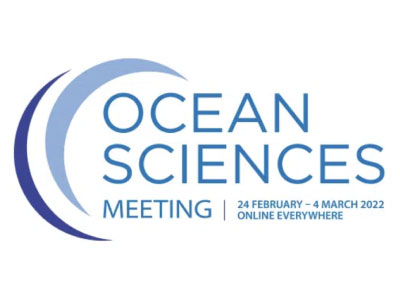Science Meetings
2022 Ocean Sciences Meeting
February 24 - March 4, 2022Virtual
Website
Co-sponsored by the American Geophysical Union (AGU), the Association for the Sciences of Limnology and Oceanography (ASLO), and The Oceanography Society (TOS), Ocean Sciences Meeting (OSM) is the global leader in ocean sciences conferences. Balance is key to OSM 22 – enabling as many people to meet as possible across media, disseminating scientific knowledge, and creating personal connections all while considering the ocean and planet we want for the future.Documents (14)

Atmospheric Correction for Ocean Retrievals from the PACE Observatory
Ibrahim, A. (03-Mar-22). NASA's Plankton, Aerosol, Cloud, ocean Ecosystem (PACE) is a climate continuity mission that aims to extend the high-quality ocean ecological and biogeochemical, clouds, and aerosols data records begun by NASA in the 1990s. 
Bio-optical Algorithm Validation in the PACE Era: Farewell to the Scatter Plot?
McKinna, L. (02-Mar-22). As the launch NASA'S Plankton, Aerosol, Cloud, ocean Ecosystem (PACE) mission approaches, we must prepare to routinely validate bio-optical data products at hundreds of wavelength. 
Chasing Carbon in North Atlantic
Cetinić, I. and Soto-Ramos, I. (01-Mar-22). How crazy do you have to be to chase carbon in the North Atlantic in the middle of the storms with three ships and a bunch of autonomous vehicles, and then try not to run anything over and then do it while finding an eddy. 
Joint Town Hall for NASA Hyperspectral Aquatic Missions PACE, GLIMR, and SBG
Turpie, K. (24-Feb-22). NASA is developing three new imaging spectroscopy missions for this decade. This town hall provides an update on each mission and a panel-led community discussion regarding cross-mission collaboration and the potential of combined observations as a constellation. 
Keeping PACE with the NASA Plankton, Aerosol, Cloud, ocean Ecosystem Mission
Werdell, J. (03-Mar-22). This presentation will showcase the current status of the NASA Plankton, Aerosol, Cloud, ocean Ecosystem (PACE) mission. 
Machine Learning Approaches for Predicting Phytoplankton Community Composition from Ocean Color
Craig, S. (03-Mar-22). In preparation for the upcoming PACE and GLIMR missions, we are developing a Bayesian machine learning (ML) approach to use hyperspectral ocean color (OC) measurements & ecological principles to accurately describe phytoplankton community composition. 
Multidisciplinary Insights into Pathways of Carbon Export [Session]
Cetinić, I. (03-Mar-22). This session welcomes research topics employing ecological, biogeochemical and physical observations aimed at improving quantification and understanding of biologically-mediated carbon fluxes in the ocean. 
NASA PACE Mission: Advanced Hyperspectral and Multi-Angular Polarimetric Satellite Observations for Ocean Science, Conservation, and Management Applications
Urquhart, E. and Sadoff, N. (28-Feb-22). This poster provides case studies and Early Adopter projects where PACE is enabling the continuation of heritage MODIS and VIIRS visible, near-infrared, and shortwave-infrared data products at 1 km resolution, as well as producing new hyperspectral and multi-angular polarimetric advanced data products not possible with MODIS and VIIRS due to their design and technological limits. 
NOMAD v3.0: Supporting PACE Mission for Validation and Algorithm Development
Sanjuan Calzado, V. (01-Mar-22). PACE, Plankton, Aerosol, Cloud, ocean Ecosystem is a new NASA ocean color mission which aims to extend ocean color, aerosol, and cloud data records with advanced instrumentation surpassing previous and current missions. 
Pursuing Data-Driven Water Quality Monitoring and Forecasting via the NASA PACE Applications Program
Sadoff, N. and Urquhart, E. (04-Mar-22). This talk provides an overview to PACE Applications and PACE data related to water quality monitoring and forecasting, with best practices and lessons learned offered for enhanced decision-making activities, considerations for new observations and data products, as well as insights for the UN Sustainable Development Goals (SDG-6 (Clean Water), SDG-14 (Life Below Water), and SDG-17 (Partnerships), and the Group on Earth Observations (GEO) AquaWatch Initiative. 
Success Stories of APPS, Trainings and Engagement Getting Near Real Time Data to Water Managers Monitoring for Cyanbacteria Blooms
Seegers, B. (28-Feb-22). Cyanobacteria blooms are a water quality issue that impacts ecosystem and human health, recreational opportunities, and local economies. Therefore, there is interest in monitoring for these harmful cyanobacteria events. 
Training Data for Phytoplankton Community Characterization from Ocean Color
Carroll, I. (03-Mar-22). CE data will drive new machine learning (ML) applications, including the model we are developing to predict phytoplankton community composition (PCC) from hyperspectral ocean color. 
Ushering in a New Era of Hyperspectral and Polarimetric Radiometry for Remote Sensing of Global Ocean Ecosystems [Session]
Werdell, J., McKinna, L., Cetinić, I., and Dierssen, H. (28-Feb-22). We welcome research that challenges existing paradigms in our understanding of the capabilities of the remote sensing observation of the global ocean, particularly with a broad eye on the use of hyperspectral ocean color and multi-angle polarimetric observations. 
Why PACE is an Atmospheric Mission and Why it Matters to You, an Ocean Scientist
Remer, L. (28-Feb-22). The Plankton, Aerosol, Clouds, ocean Ecology (PACE) mission will push satellite observations of ocean biology to the next level. However, half of PACE's scientific potential is understanding the atmosphere. 
